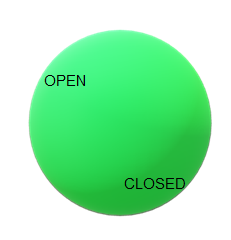8
Poetic Form: Open and Closed
Closed form poetry did not just dominate poetry from its origin up to the end of the 19th century, it was synonymous with poetry. For thousands of years all poems were written in closed form. It was not until the middle of the 19th century that poets like Walt Whitman in America and a group of French poets (who came up with the term vers libre) gave up on meter and begin to write poems without any prescribed forms. Indeed the first, easiest test of whether a poem is in open or closed form is simply to know when it was written: before 1850, closed; after 1850—better check and see.
But that won’t tell you anything about what makes a poem “open” or “closed.”
Two ways of thinking about form.
The poetics you were introduced to in the previous lecture was all about so-called “closed” or “fixed form” poetry. The word “closed” (or “fixed”) must be understood properly. In fact, language itself is never absolutely open or absolutely closed. On the one hand, language is always more or less fixed—by grammar, syntax (word order) and the meanings of the words.
- If I say “I locked my keys in the car” everyone will know what you mean. These are the words the language asks you to use and this is the order you are expected to put them in if you want to say the thing expressed here. There aren’t a lot of ways to say it. And if you do try to say it another way, you risk not being understood. Language is always more or less closed.
But on the other hand, language is always also more or less open; within the restrictions of grammar, syntax and meanings, you can always say new things. You can recombine words, you can use old words in new says, you can reorder phrases in new ways. It would not be language if content didn’t play (move about) within form like furniture in a house. Language needs to be both open and closed to function.
- You can say, “my car was locked with the keys inside.” Or “Inside my locked car are my keys.” You can say, “my keys were locked in the car.” People will understand you if you say, “Locked in the car were my keys.” But they’d think you were weird. (You can also say, “I locked my keys in the car” and mean, as a secret code, “I left the disk drive with the secret formula in my computer.” But you’ll probably have to establish the code beforehand.) But you probably can’t say with any hope of being understood, “Keys my in car left locked I.” Not even Yoda has that much freedom.
So, to repeat: language itself is always more or less open, more or less closed.
So what do we mean when we call some poems “open” and some “closed.”
There are two ways to think about this. Both of them apply.
In fact all poems exist on a continuum. All fit in the same circle, some toward the top, some toward the bottom,

But imagine if we had a class of eighth graders and we had to put them into two groups: tall and short. There will be some in the middle. But we don’t have a middle circle. Everyone is marked as “tall” or “short.”
- When critics and other readers use the words “open” and “closed” they tend to think of them as designating two fields that never touch.

They put some poems in the left circle and some in the right.
Although it can be misleading, it is also useful. The judgment is made based on certain criteria, the most important of which is meter.
But before we talk we talk about that, for practical purposes we can make this very simple:
If a poem doesn’t rhyme, you can be about 90% sure an open form poem. If a poem is not in meter, you can be about 99% sure it’s open. When we are thinking about what makes a poem closed form, we’re less concerned about classifying poems, which is pretty easy, than about the important ideas of “openness” and “closedness.”
So, again, we say that poems that lack rhyme and meter are “open” in form and poems that have rhyme and meter are “closed.” And that way of thinking will cover most of what we need to say this week.
But we can do better. Once you start studying what is called “open” and “closed” form, things start to become complicated.
What is called closed form poetry is an organization of language that adds more than common rigidity to language and then tries to create the maximum possible freedom—or openness—within that space. Closed form is an obstacle course for the poet to run language through as gracefully as possible. Watching language run gracefully through these often formidable obstacles is one of the greatest pleasures of reading poetry.
While there is more than one way for a poem to be considered closed, the vast majority of poems are called closed because of their steady beat. Closed form poems also often rhyme, and when they rhyme they do so in consistent and sometimes complex patterns. They also often repeat the same stanza over and over. But it is the meter not the rhyme or the stanza that defines the type.
The Varieties of “Closed Form.”
Although meter has been the most prominent element in closed form poetry since the middle ages, there are other things besides meter that determine whether or not a poem is in closed form. But let me be clear here: if a poem is written in meter, it’s closed. Period. As for rhyme, while most poems that rhyme are closed and most open form poems do not rhyme, rhyme alone is not a good indication of whether a poem is in open or closed form. Why? Open form poems sometimes use rhyme (in a limited way), but more importantly many closed form poems do not rhyme.
So what besides meter can close a poem?
Alliteration can. Old English poetry (like Beowulf) was written in alliterative verse. Alliterative poetry is closed by the number of repeated sounds in the line. The line of an alliterative poem has, usually, three instances of the same sound (note the “f” sounds this line: “The folk-kings’ former fame we have heard of”). Alliterative verse does not necessarily count stresses or syllables, only alliterative sounds.
Accent Count Sometime Old English alliterative verse does count accents. When it does, or when any verse does, we call that “accentual verse.” In this type, you can have as many unstressed syllables as you want, but the accented syllables remain constant or follow a pattern.
Syllable count Syllabic verse (such as haiku) counts only syllables. It is not written in meter or rhyme. In fact any poem that maintains the same number of syllables in each line or in corresponding lines in each stanza is closed by syllable count alone.
Accentual-syllabic As you may have guessed from the name, if you count both the syllables and the accents, you have accentual-syllabic verse. The sonnet is an accentual-syllabic form. But so is most English-language poetry.
Pre-established form. Named forms, such as villanelle and sestina (we’ll learn about them later in the term), are determined by word or line pattern. Villanelles rhyme, but they don’t have to be in meter. Sestinas don’t rhyme and are rarely in meter.
If none of these criteria apply (meter, alliteration, syllable count or form name), then you can be pretty sure your poem is in open form.
Open (Free) Form
Open form poetry is significantly less rigid than closed form, and it is only by contrast with closed form that it can be called open. It is usually less rigid in regard to line, stanza, meter, and subject matter—in short everything formal that has traditionally made a poem a poem. It seems to be in some ways closer to prose than to closed form poetry but, at the same time, still not so “open” as prose generally is.
The pleasure we get from closed form is to see how the language can play—can create room—within rigid form. That’s why knowing the forms helps us appreciate and enjoy that poetry more. To say it another way, we look for what freedom the language can attain within the artificial restraint of form.
That advantage is lost in degree as the form becomes less restricted. If other pleasures do not compensate, the movement from closed form to open is wasted. The pleasure offered by open form poems certainly runs the risk of not being the pleasure of poetry.
Before talking more about this sort of poem—which became so dominant in the twentieth century that for many years other forms of poetry were rarely published—let’s look at a few examples.
Here’s a particularly notorious example by William Carlos Williams (you certainly can’t say it’s hard to read):
The Red Wheelbarrow
so much depends
upon
a red wheel
barrow
glazed with rain
water
beside the white
chickens.
We can talk about this poem in detail in our discussion. But for now, I want to ask the question: in what sense is this verse free? Well, it doesn’t rhyme. It does not have a consistent meter. But it does have a consistent line and stanza: each stanza consists of one three-word line followed by one one-word line. Williams has even broken up the single word “wheelbarrow” into two words to fit his form. It is as rigorous as haiku in its way. It just doesn’t follow rules previously put down by a poetic tradition. Because the history of poem does not consider word count (as distinct from syllable count) an element of closed form, the poem is considered to be open form. It would show up near the middle of our continuum circle.
Here’s another:
Sea Rose
Rose, harsh rose,
marred and with stint of petals,
meager flower, thin,
sparse of leaf
more precious
than a wet rose
single on a stem—
you are caught in the drift
Stunted, with small leaf
you are slung on the sand
you are lifted
in the crisp sand
that drives in the wind.
Can the spice-rose
Drip such acrid fragrance
Hardened in a leaf?
Again, in what way is this poem free? Well, in addition to the ways that Williams’ poem is free, this one lacks a consistent meter, line and stanza. It seems to have a consistent four-line stanza through the first two. But then the next one is five lines and the final one three. (Look how easily the poet could have turned these sixteen lines into four-line stanzas if she had wanted to.) It would be closer to the top of our circle than “The Red Wheelbarrow.”
Free verse is generally easy to recognize. What is harder to recognize is the principle of order that free verse poems employ. There usually is one: it may be the number of words or syllables in a line, it may be the grammatical clause; it may be the principle of the breath (the line pauses when the poet expects the reader to breathe), or it might be that the line seeks the most dramatic moment at which to break. It may be that the first word of the next line changes the meaning of the last word of the previous one, as the word “not” did in the recent language fad when it was stuck at the end of a sentence. For the sake of analysis we do want to discover what makes a free verse poem a poem, and not just broken up prose. But if it is a matter of identifying the form of the poem, this is much simpler: anything that’s not closed form, is open.
One of the things you discover in reading open form poems is that each must be taken in itself, with as few preconceptions as possible. Each time you may ask again, “What’s going on here?” We will continue to pursue these questions in class discussion.
How did poems become open anyway?
But before ending this lecture it might be useful to pursue, briefly, one other question: What happened here? How did closed form poetry so suddenly become open form poetry?
That question has been answered in diverse ways. I will mention only two.
- Formally, the problem faced by early twentieth-century when the popularity of open form began to overtake that of closed form, English language poets felt a sense of the used-upness of closed form. It was believed by many that form had been exhausted, that nothing new could be done with it, that nothing new could be said in it. It’s certainly true that there are a limited number of things that can be done in meter, and that after 900 years or so, meter and rhyme were becoming a little old.
- Ideologically, the problem was that closed form didn’t seem to fit the times. The way we say things says a lot about how we think. Closed form expresses a more rigid view of the world, one more sympathetic to monarchy than to democracy. (Walt Whitman in the middle of the nineteenth century had already rejected traditional closed form for his democratic poem.) Open form simply fits better with the open twentieth-century view of the difference and the significance of the individual.
Here’s a flow chart for the confused. You’ll have to copy it or right click and open it in a new tab.
Some Poems:
“Caedmon’s Hymn” (Links to an external site.)
Audio recording (Links to an external site.)
Geoffrey Chaucer, “From The Canterbury Tales, The General Prologue,” ll. 1-42 (Links to an external site.)
Anonymous, “Western Wind”
Anonymous, “Bonny Barbara Allen”
Edmund Spencer, “From The Faerie Queen,” stanza I (Links to an external site.)
George Herbert, “Easter Wings” (Links to an external site.)
“The Collar” (Links to an external site.)
Samuel Taylor Coleridge, “Kubla Khan”
George Gordon, Lord Byron, From Don Juan, the “Dedication.” (Links to an external site.)
Edgar Allen Poe, “The Raven” (Links to an external site.)
Alfred, Lord Tennyson, In Memoriam A.H.H. “95 (Links to an external site.) [By night we lingered on the lawn]”
Thomas Hardy, “During Wind and Rain” (Links to an external site.)
WIlliam Carlos Williams, “The Red Wheel Barrow” (Links to an external site.)
“The Dance” (Links to an external site.)
H.D. “Sea-Rose” (Links to an external site.)
E. E. Cummings, “anyone lived in a pretty how town” (Links to an external site.)
Langston Hughes, “The Negro Speaks of Rivers” (Links to an external site.)
Marianne Moore, “The Fish” (Links to an external site.)
Gwendolyn Brooks, “We Real Cool” (Links to an external site.)
John Hollander, “Swan and Shadow” (Links to an external site.)

